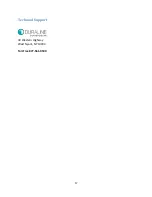
7
How Can Sound Waves and Ultrasonic Cavitations Clean?
When a sound wave travels through fluid, it stretches and compresses the fluid to
transmit sound. When the sound wave's amplitude increases to a threshold level, when
the fluid cannot hold the “stretch” of the sound wave, the sound wave energy literally
tears the water apart and vacuum bubbles are formed.
Each vacuum bubble grows in size until it can grow no more
– equilibrium is reached
between the bubble and the fluid
– at equilibrium, the bubble is compressed by the
surrounding fluid pressure until it collapses. At collapse, a tiny liquid jet is created in the
bubble’s place.
Each liquid jet creates estimated temperatures and pressures of over five thousand
degrees Celsius and ten thousand PSI when the collapse occurs. The extreme pressure
and temperature of the jet provides the phenomenon responsible for the effective
ultrasonic cleaning action. This action occurs millions of times, over and over, while the
sound waves are traveling through the fluid.
Ultrasonic Cleaning Cleans Every Nook and Cranny
When the item being cleaned is sub
merged in the ultrasonic tank’s fluid, the millions of
jets created by ultrasonic energy are capable of reaching into fine depressions and
intricate details. Every surface area is exposed to the ultrasonic cleaning action; cracks,
crevices and hard to reach corners of every nook and cranny get cleaned by the
ultrasonic cavitating action. Ultrasonic sweep cleaning technology enhances the
system’s ability to clean.
Ultrasonic Cleaning Power and Frequency
Ultrasonic system power is rated in how much energy, in watts, is generated in the
ultrasonic tank. Higher power systems generally mean shorter part immersion times in
the fluid. The ideal cleaning frequency is determined by the size of dirt being cleaned.
Simply speaking, higher frequencies are more capable it is of removing smaller
particles, lower frequencies are better suited for large dirt particles.
Many ultrasonic systems can be configured with multi-frequency technology, giving you
the benefit of multiple cleaning frequencies in a single design package.
Operating Your Cleaner
If this is the first time you are using the cleaner, please read this whole section before
operating your cleaner.


























